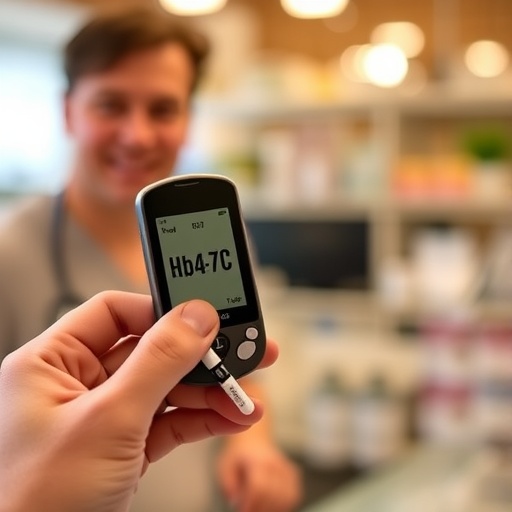In an era where rapid diagnostic capabilities are increasingly vital to effective healthcare management, a recently published study sheds light on the significant implications of point-of-care testing (POCT) for patients with type 2 diabetes. The research, led by a team of dedicated scientists, reveals a notable correlation between the use of POCT and reductions in HbA1C levels, a crucial marker for long-term glucose control. This groundbreaking work provides both clinical insights and pragmatic solutions for healthcare practitioners aiming to improve diabetic patient outcomes.
The study presents a comprehensive analysis involving a carefully constructed cohort, rigorously matched on various clinical parameters to ensure the validity of findings. By employing propensity score matching, the authors, Chen, Y., Chen, T., and Qu, L., establish a robust research design that effectively minimizes biases typical of observational studies. The attention to detail in methodology reinforces the credibility of the findings, emphasizing their potential applicability in real-world clinical settings.
HbA1C serves as an essential predictor of both the risk of diabetes-related complications and overall patient prognosis. Monitoring this biomarker can provide critical insights into a patient’s long-term glycemic control. The study builds a strong case for POCT’s role in enhancing monitoring capabilities, making it easier for both patients and healthcare providers to make informed treatment decisions. This immediate access to crucial test results can lead to timely interventions, thus improving patient outcomes.
Furthermore, the research highlights the convenience associated with point-of-care testing. Traditionally, patients would have to wait for days to receive lab results from centralized laboratories, creating delays in treatment modification and patient management. Such inefficiencies can lead to worsening of health outcomes, particularly in vulnerable populations like those with diabetes. The study showcases how POCT can bridge this gap, allowing for rapid decision-making and immediate therapeutic adjustments when necessary.
In this context, the implications of timely HbA1C monitoring through POCT can be transformative. Regular feedback regarding glycemic control fosters a culture of proactive engagement in treatment plans. It motivates patients to adhere to lifestyle and medication regimens, ultimately facilitating better blood sugar management. With enhanced patient-provider communication, characterized by immediate insights, the foundation for a successful therapeutic alliance is strengthened.
The rigorous design of the study incorporates a diverse cohort representative of various demographics, enhancing the generalizability of its findings. This aspect is particularly important in diabetes research, where variability in response to treatment can fluctuate widely among different ethnic and socio-economic groups. By ensuring inclusivity in participant selection, the authors provide a more accurate reflection of how POCT might benefit a broad spectrum of individuals living with type 2 diabetes.
Beyond statistical analysis, the research contributes significantly to the ongoing discussions surrounding diabetes management strategies within the healthcare community. It offers compelling evidence for the integration of innovative diagnostic technologies into standard clinical practice. With an ever-increasing burden on healthcare systems worldwide due to the rise of chronic diseases, findings such as these prompt reconsideration of conventional testing paradigms.
Another insightful aspect of the study lies in its focus on healthcare costs. As point-of-care testing becomes more widely adopted, the potential to reduce overall healthcare expenditures through enhanced patient outcomes cannot be underestimated. By preventing complications arising from poorly managed diabetes, POCT may save significant costs associated with hospitalizations, emergency room visits, and long-term treatments for advanced complications. Thus, investment in such technology can yield substantial returns in multiple dimensions of the healthcare system.
Moreover, point-of-care testing aligns well with the principles of patient-centered care, emphasizing the importance of personalized approaches to treatment. The immediacy of test results supports shared decision-making, enabling patients to play an active role in their management. By providing patients with the tools they need to understand and control their condition better, healthcare providers can foster a collaborative environment conducive to improved health outcomes.
The implications of this study extend to public health discussions as well. With diabetes prevalence on the rise globally, effective interventions become paramount to mitigate the burgeoning crisis. The integration of POCT into diabetes management protocols could serve as a scalable model for healthcare systems grappling with the dual challenges of rising patient numbers and constrained resources.
The findings presented by Chen, Y., Chen, T., and Qu, L. advocate for a reevaluation of current diagnostics related to diabetes management. Policymakers, healthcare leaders, and practitioners alike are encouraged to consider strategies for incentivizing the adoption of POCT in various healthcare settings. Collaborations among stakeholders can lead to innovative solutions that harness technology for better health outcomes, particularly in chronic disease management.
In summary, the study represents a significant step forward in understanding the role of point-of-care testing in the management of type 2 diabetes. By illustrating the positive effects of POCT on HbA1C reduction, it paves the way for evidence-based strategies that prioritize efficiency, accuracy, and patient engagement. As our healthcare landscape continues to evolve, such insights are crucial in guiding clinical practices that encourage tangible improvements in patient care, ultimately leading to better health outcomes for millions living with diabetes.
With a strong foundation laid by robust research methodology and compelling results, this study underscores the transformative potential of point-of-care testing in chronic disease management. As the healthcare community anticipates further innovations, the findings of this research will undoubtedly fuel ongoing discourse on optimizing diabetes care for future generations.
Subject of Research: Impact of Point-of-care Testing on HbA1C Reduction in Patients with Type 2 Diabetes
Article Title: Impact of Point-of-care Testing on HbA1C Reduction in Patients with Type 2 Diabetes: A Propensity Score-matched Cohort Study
Article References:
Chen, Y., Chen, T. & Qu, L. Letter to the Editor: Impact of Point-of-care Testing on HbA1C Reduction in Patients with Type 2 Diabetes: A Propensity Score-matched Cohort Study.
J GEN INTERN MED (2025). https://doi.org/10.1007/s11606-025-09800-3
Image Credits: AI Generated
DOI: 10.1007/s11606-025-09800-3
Keywords: Point-of-care testing, HbA1C reduction, Type 2 diabetes, Propensity score matching, Diabetes management




